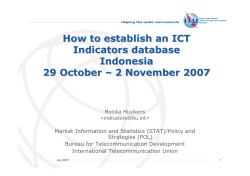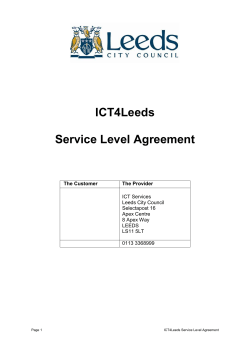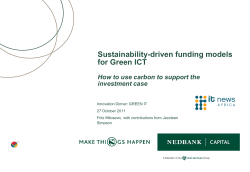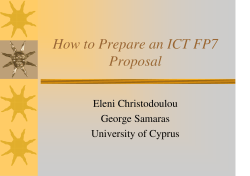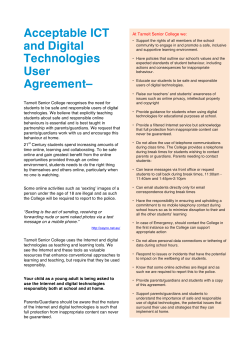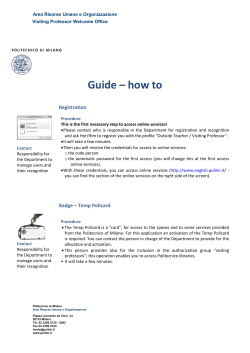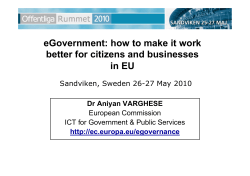
Seminar on How To Promote ASEAN Spirit ASEAN-COCI
Seminar on How To Promote ASEAN Spirit ASEAN-COCI 17-20 March 2009 Grand Mercure Fortune, Bangkok, Thailand PREPARED BY: Chong Youn Bao Dk Siti Nuraini Pg Haji Tajudin Mazriyani Haji Abdul Ghani Rodziah Haji Yussof of BRUNEI DARUSSALAM Abstract: How to Employ ICT to Promote ASEAN Spirit & Generate Awareness and Understanding about ASEAN Introduction To Brunei Darussalam Brunei Darussalam is a Malay, Islam Monarchy and an independent sovereign Sultanate governed on the basis of a written constitution. Brunei Darussalam is situated on the north-west of the island of Borneo, 287 miles [442 kilometres] north of the equator. It has a total area of 5,765 square Km with a coastline of about 161km along the South China Sea. Brunei Darussalam is divided into four districts namely Brunei-Muara, Tutong, Belait and Temburong. The capital, Bandar Seri Begawan is siuated in The Brunei-Muara district. Brunei Darussalam is currently ruled by Ke-bawah Duli Yang Maha Mulia Paduka Seri Baginda Sultan Haji Hassanal Bolkiah Mu‟izzadin Waddaulah ibni Al-Marhum Sultan Haji Omar Ali Saifuddien, Sa‟adul Khairi Waddien, Sultan dan Yang Di-Pertuan Negara Brunei Darussalam. His majesty is the 29th Sultan of Brunei Darussalam. ICT Development in Brunei Darussalam The rapid development of Information and Communication Technology (ICT) and related technology during the last few decades has made significant impact in transforming many aspects of our daily activities. In fact ICT has a great influence towards the way people think and adapt to the digital age as it helps to provide effective and excellent services. The government of His Majesty the Sultan dan Yang Di-pertuan of Brunei Darussalam realizes the importance of information, Communication Technology (ICT) infrastructure and services to accelerate socio-economic development and has invested heavily in infrastructure development over the last 10 years. Under the National Development Plan (RKN) 2007-2012, the focus will not only be on the provision of basic ICT infrastructure but also enhancing human capacity, integrating ICT effectively and advancing eBusiness. 2 ICT Organization in Brunei Darussalam There are several bodies involved in the implementation and development of ICT in Brunei. The important organizations are as follow: 1. Ministry of Communication The Ministry of Communication was set up in the year 1984, soon after Brunei Darussalam gained its independence with the vision “Towards a Sophisticated Society and Excellence in Communications for Enhancing National Competitiveness.” Their objectives focusing on ICT are: to create a series of incentives for the local ICT industry and to develop local ICT players capable of implementing e-government projects. Hence, the Ministry seeks to engage and collaborate closely with relevant agencies and hence it will continue to deregulate services and liberalize the communications sector. 2. Ministry of Education The Ministry has devised ten-year strategic objectives (2006 – 2015) prioritising human resource development in order to meet Brunei Darussalam‟s need for an educated and marketable workforce. The education system also aims to inculcate sound moral values as a strong foundation in an era of rapid progress and change. To meet future challenges in an ever-changing world, the Ministry has developed a vision of „Quality education towards a developed, peaceful and prosperous nation‟. We believe this vision will realize the nation‟s aspirations and produce citizens who are committed and capable of contributing towards the continued growth, stability and prosperity of the country. 3. Brunei Economic Development Board (BEDB) BEDB is a statutory board established by His Majesty The Sultan and Yang DiPertuan of Brunei Darusslam in November 2001 to be the leading economic development agency for Brunei Darussalam. The aim of BEDB is to create employment and business oppurtunities; BEDB is constanly analyzing new areas for 3 economic development and welcomes investor proposals or enquiries on partnership and investment opportunities in Brunei Darussalam. 4. Brunei Darussalam Information Technology (BIT) Council BIT is formed in order to establish and provide ICT leadership and direction at the national level. The role of BIT will be providing the linkages and interactions of ICT development in the public and private sectors thereby creating synergy to move the country to the forefront of ICT development. 5. Authority for Info-Communication Technology Industry of Brunei Darussalam AITI is established on 1st January 2003 as an independent statutory body to regulate, license and develop the local ICT industry and manage the national radio frequency spectrum. 6. Telekom Brunei Berhad (TelBru) 1st April 2006 marked the corporatisation of Telekom Brunei Berhad (TelBru) which means the separation of service provider and regulatory functions previously held by Jabatan Telekom Brunei. Telekom Brunei Berhad (TelBru) as the successor company will be the service provider in delivering info-communication services and Authority for Infocommunications Technology Industry of Brunei Darussalam (AiTi) is responsible to license, regulate and develop the local ICT industry and manage the national radio frequency spectrum. 7. DST Communications Sdn Bhd DST Communications Sdn Bhd is a provider of world-class mobile communications services for the business, local and foreign communities of Brunei Darussalam. Since its inception, it has grown from an AMPS type analogue telephone service provider to introducing GSM (Global System for Mobile Communications) services, to recently adopting 3.5G HSDPA (High Speed Downlink Packet Access) services, putting it on par with the world's top network operators and service providers. This 4 also includes the provision of international roaming facilities to more than 70 countries in four continents. DSTCom's progress is also marked by the continued increase in the number of customers throughout Brunei Darussalam - a base of around to 300,000 customers, being served by more than 460 skilled and dedicated employees. 8. BMobile In September 2005, B-Mobile Communications Sdn Bhd became Brunei‟s first 3G mobile service provider. Being a joint venture between Telekom Brunei Berhad (TelBru) and QAF Comserve, BMobile has access to resources, expertise, technologies and infrastructure to thrive in the industry. 5 Usage of ICT in Brunei Darussalam The usage of ICT in Brunei has been increasing ever since ICT was introduced in Brunei Darussalam. The following are some of the statistics on the usage of ICT in Brunei: Internet service providers – TelBru and DSTCom 6 ICT Implementation in Brunei Darussalam There are many initiatives that are being developed and performed in order to improve the implementation of ICT and to use it effectively and efficiently. They are as follow: 1. e-Government e-Government is the use of information and communication technologies (ICTs) to deliver government e-services to the citizen, government employees and businesses. Brunei e-Government vision is "To be an e-smart government in line with the 21st century civil service vision". The mission is "His Majesty's Government aims to establish electronic governance and services to best serve the nation”. Currently, the focus of eGovernment is to implement projects that are citizen-centric in nature. 2. e-Education Brunei e-Education vision is “Transforming Brunei Darussalam to a more knowledgeable, thoughtful, multi-skilled, competitive and smart nation upon the teachings of Islam”. The mission is “To enable access for all to e-Education by providing a strong foundation in ICT thereby promoting excellence in human capacity building”. One of the program under e-Education is e-Learning. This E-learning system will allow universities and colleges to start distributing learning materials electronically, implementation of a Learning Management System, instructional design facility, provision of authoring tools, notebooks and digital contents. Another program under e-Education is e-Library and Virtual Library. e-Library is one of the Ministry of Education‟s digital library initiatives introduced in May 2005. It aims at improving the infrastructure of the university library‟s information management systems. The components of the project are: the digitization of the university information resources and publications; the upgrade of library management systems; and the implementation of the university library digital portal. 7 Virtual Library System or VILIS Brunei Darussalam aims to serve the informational needs of the country‟s teaching and learning communities. It‟s a digital library offering services beyond library catalogue and library building. It will provide UBD‟s Library with relevant information infrastructure and application software to fully utilise e-initiatives and deliver its e-commerce agenda. How to Employ ICT to Promote ASEAN Spirit & Generate Awareness and Understanding about ASEAN ICT has become one of the important driving forces for modern development nowadays. The advent of ICT brings all the citizen of this planet close together and has a quicker access to all the information and benefits that the world may have. With reference to the world Internet users and population statistics, it is estimated that about 650.4 million of Internet users are coming from Asia followed by Europe with estimation rate of 390.1 million users [1]. Globalization and other trends in today‟s society claim for more flexibility in time and space, and it concerns people both in working life and in private life. With means of ICT 8 opportunities may give citizens access to services almost 24 hours a day and offers thereby new opportunities for organizing and living everyday life [2]. The use of computers, the Internet and other related technologies are becoming more and more ubiquitous. Technological literacy or the ability to use ICT effectively and efficiently is thus seen as representing a competitive edge in an increasingly globalizing job market. As a result of the current issue, ICT is now commonly implemented in schools and higher institutions with means of helping the individuals to prepare for the workplace environment as most government offices and business organizations are in demand of ICT based. There can be a generation gap in how youth and adults view the value of online activity. Adults might think that the implementation of ICT in lower institutions or particularly among youth generation might spoil their way of thinking and for kids spending time online might be dangerous or even making them lazy. The primitive way of thinking may not be applied today as an individual must realized the impact of spending time online is essential for young people to pick up the social and technical skills they need to be competent citizens in the digital age. In fact, youth are learning basic social and technical skills that they need to fully participate in the contemporary society. Youth nowadays even known to social networking activities and this has become a major trend among the youth such as using Facebook, Friendster, MySpace, Flicker, YouTube, and others. Social networking often involves grouping specific individuals or organizations together with means of connecting with people in different locations and of different age who share interests. With reference to the Social Networking Statistics and Trends, more than 60 million active users accessing Facebook with an average of 250,000 new registrations per day since January 2007. Whereas YouTube ranks as the number one for all online video websites ranked by market share of United States Visits and about 52% of users range from 18 to 34 years old share videos often with friends and their colleagues [3]. Based from this, it shows that social networking activities are the most common and current activities done online. With the existence of social networking among the young generation might help to boost the ASEAN spirit by starting a networked ASEAN group community where all people 9 from various age generation may involve in the group discussion or networked forum which based on developing ASEAN content. It is beneficial to have such networked forum where all participants particularly targeted on ASEAN countries to exchange their culture, language and updated news about their country through the group discussion. In addition, through this less costly media access tools try to unite the ASEAN people together and in a way has a quicker access to all the information and benefits that the world may have. With the readiness of ICT technologies such as the availability of computers and internet access in most schools and higher institutions nowadays, we can make learning environment more interactive and fun. As in Brunei, the Ministry of Education (MOE) is making every effort to fully utilize ICT in every aspect of teaching and learning activity through the e-Education project. As mentioned by the acting minister of MOE during the opening ceremony of the Second Regional Workshop on ICT Integration Training for the Next Generation of Teachers [4], “the e-Education project includes the provision of schools' ICT infrastructure, provision of ICT being integrated into the curriculum, teacher training, pedagogy and the need to train all the teachers to acquire basic competency and skills in ICT by providing them with International Computer Driving License (ICDL), ICT courses and the use of the Interactive White Board”. Studies have not only shown how interactive whiteboard (IWB) have a positive impact on engagement, interaction and motivation in whole class teaching but as a catalyst for a paradigm change to whole class instruction. As one of the Ministry of Education eEducation Project, the main strategic objectives of the IWB for interactive teaching and learning are to transform teaching and learning into an engaging and active process and to foster a conducive and motivating environment for teaching and learning with IT. Currently, 244 IWB have been installed in all government educational institutions that include primary, religious, secondary, vocational, technical colleges and higher institutions [5]. By leveraging on this technology, the information/content of ASEAN can be included as part of subject lesson. 10 Other than promoting ASEAN spirit through web centric based, we may come up with plan of having ICT ASEAN Youth Camp. This ICT ASEAN Youth Camp can be of various activities to promote the usage of ICT among youth and of developing the ASEAN content such as writing essay competition, interactive culture games competition, software or applications development competition and others. With such ICT activities held not only build the confidence of an individual, it also aim to allow them to utilize ICT appropriately in their learning as well as provide the mind-boggling educational experiences for students through the use of important productivity software that will be required by students in future careers. These activities also encourage the youth to have a social network among the ASEAN participants and in fact they will learn and share each other countries‟ culture, language and spirit. One complication that leads to the unawareness of ASEAN among youth might be the lack of youth representatives from ASEAN. As mentioned in the previous section, there can be a generation gap between youth and adults, in terms of how they both see and manage things. The world is changing rapidly towards a more technological society and thus the current youth generation may have experienced things that the previous generation may have not undergone. So there can be more youth representative from ASEAN who can organize activities and events that may be more interesting to the youth in ASEAN countries. There should be a combination of youth and senior members in ASEAN committee that will narrow the generation gap and thus leads to the mutual understanding between the two different generations. 11 Aside from that, there can be more seminars and trainings on ASEAN related content. In education prospect, there can be more ASEAN exchange students and teachers. In this way, they will be able to learn about the culture and structure of a particular country, this may includes the organization, development and implementation of ICT; with this knowledge and information, they will be able to study and actually implement these knowledge into their own countries. Challenges in Implementing ICT There are several challenges that need to be considered before actually implementing ICT. One of the major challenges is the Digital divide. Digital divide refers to the gap between people who are able to access to digital and information technology effectively and those who may have limited or none at all. The existence of this challenge may due to the fact that there is a lack of budget for developing and implementing ICT, which is quite common in some countries. Without the resources, it is impossible to make plans for implementing ICT. In Brunei there are cases of digital divide; one of the examples will be implementing ICT in rural areas. This problem actually relates on how to reach, within a reasonable time, the needs of the poor, uneducated and those who live in rural areas. The solution to this problem can be the setup up of community center in each of the rural areas; this community center can be facilitated with computers with access to the Internet. In this way the people in the rural areas will have access to the ICT. The community center can have few sessions of training or activities in a week that will teach the people who are unfamiliar with the ICT facilities. After the people gain basic knowledge of using ICT, the community center may slowly introduce ASEAN into the content of the training sessions or activities. The introduction of ASEAN may start from the basic look up of ASEAN community in the Internet through search engines. In this way, the people will be influenced and be aware of what ASEAN organization is all about. The youth group who always have more curiosity will eventually find out more about ASEAN and what impact ASEAN have on each members (countries) of its organization. 12 On the other hand, after implementing ICT, there can be problems of employing licensed software which may require some payments to the license and maintenance of the software. This payments can varied differently depending on the services provided by the software, but in reality the more expensive the software is the better the support given by that software. Thus to solve this problem, FLOSS can be used. FLOSS stands for “Free Libre Open Source Software”. It is software which grants the users the right of able to study, change, and improve its design through the availability of its source code. FLOSS can be free to distribute, free licensed and free of cost. Thus FLOSS plays an important part in helping those who have tight budget concerning the use of software. Since there is the availability of the source code of FLOSS software, people will be able to modify the source code to improve the performance of the software and distribute them to others. In this way, the software will be developed towards perfection with the help of everyone who contributes ideas and effect into it. People will also be able to modify the FLOSS software to suit their own means, e.g. A Malay language only supported Graphical User Interface (GUI) can be modified to support multiple languages such as Thai, Chinese, and English etc. The usage of FLOSS in ICT can be a great leap towards cutting down the budget for using licensed software. It may not be common in most places, but it will surely have its important status in the near future. During 3rd March 2009, Universiti Brunei Darussalam (UBD) held a FLOSS workshop that invited teachers from Vietnam, Cambodia and Laos for a 3 days session of training and presentation by the lecturers of UBD. These teachers were given training and presentation of using Open source software. An IBM was also invited to give presentation on Open source software and shared his experiences in using and applying this software. Thus this can be a good example of sharing and distributing the knowledge of FLOSS not only locally but also to people from other countries. 13 Conclusion In summary, the fastest and implementable means to promote ASEAN spirit is through social networking. What is required is to put proper content and sites so it is easily and readily available whenever people want to access it. With the fast moving advancement of ICT technology, language is no longer a barrier as technology will help to translate their words, to help express what we think globally and share anything we want to. In terms of cost, social networks is cost-effective because most networks are free to join. It is also hope that social network can help to deliver ASEAN message as “one vision, one identity and one community” to all the ASEAN member communities especially among the youth. 14 References [1] (Internet Coaching Library, 2009). Internet World Stats: Usage and Population Statistics. Retrieved from http://www.internetworldstats.com/stats.htm on Friday, 13 March 2009. [2] (Kajsa Ellegard & Elin Wihlborg) ICT-applications as tools for flexile everyday life – methodological considerations for making ICT- related activities seen in everyday life. Retrieved from http://72.14.235.132/search?q=cache:_zWNcsj1mwJ:www.crito.uci.edu/noah/HOIT/HOIT%2520Papers/ICTapplications%2520as%2520tools%2520for%2520flexile%2520everyday%2520life.pdf+I CT+implementation+in+daily+activities&cd=2&hl=en&ct=clnk on Friday, 13 March 2009. [3] (SlideShare Inc, 2009). Social Networking Statistics and Trends. Retrieved from http://www.slideshare.net/onehalfamazing/social-networking-statistics-and-trendspresentation on Friday, 13th March 2009. [4] Brunei on Track to Fully Utilize ICT in Schools, 13th May 2008. Retrieved from www.psctlt.org/edLAB/resources/BruneiITCSchools.pdf on Monday, 9th March 2009. [5] Enhance Teaching – Engage learning: The use of Interactive whiteboard among Teachers in Brunei Darussalam. Retrieved from http://www.moe.gov.my/43seameocc/Abstracts/Microsoft%20Word%20%20BRUNEI_Darussalam_Haji_Abdul_Rahim.pdf on Sunday, 15th March 2009. 15
© Copyright 2025


